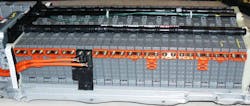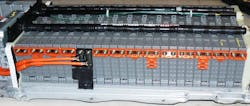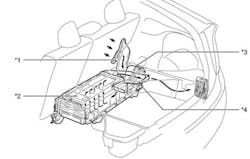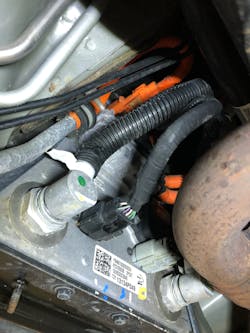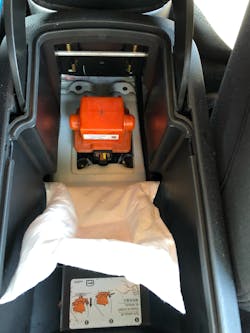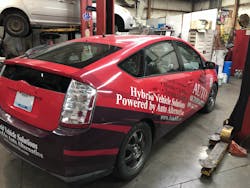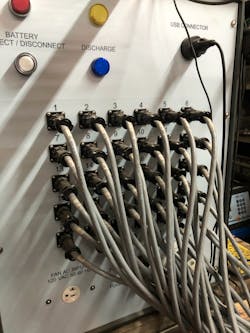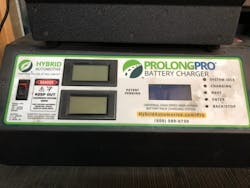Content brought to you by Motor Age. To subscribe, click here.
What you will learn from this article:
•Determine if the fault is related to the high-voltage system or the low-voltage system
•Learn how the Hybrid/BEV charging system functions and the components involved
•Learn common problems experienced and helpful tips during hybrid/BEV service, diagnosis, and repair
Your customer tells you their hybrid car won’t start. You ask the right questions and determine they have a problem with the high voltage system achieving the “Ready” to drive mode. You’ve had “some” hybrid service training and realize that this problem could have many different causes.
These vehicles are so complicated. Where do you start? Is it the “little battery” (12-volt “auxiliary battery”) or the “big battery” (high voltage) battery pack, or something else? This month, Motor Age will take you beyond the “don’t touch those orange cables” approach to electrified vehicle understanding so you can simplify the ‘complicated’ enough to get your diagnostics moving in the right direction.Sobering News; Electrified Becoming the New Normal
BEVs (Battery Electric Vehicles) are rapidly becoming the norm, thanks to environmental / government mandates. Whether to complain or celebrate is up to you, but resisting is comparable to a blacksmith refusing to work on “horseless carriages” 100 years ago. Electrified Vehicles Include:
HEVs (Hybrid Electric Vehicles)
PHEVs (Plug-in Hybrid Electric Vehicles)
BEVs (Battery Electric Vehicles)
Observations of Commonalities
12-Volt Battery (Little Battery)
All electrified vehicles have a 12-volt battery. It may be in the trunk, under the hood, or in another obscure spot. It may be a conventional lead-acid or of Absorbent glass mat design (AGM). It may be of a larger CCA rating or the size of your lawn tractor's battery. Regardless – there's a 12-volt battery on board that electrified vehicle! What is its role?
The norm is a physically smaller “L.I.” (Lighting-Starting) 12-volt battery often referred to as an “Auxiliary Battery.”
Providing the initial power for 90 % of the vehicle’s electrical system which includes all the accessories and (most importantly) the electronic module responsible for initiating the activity of HV relays (a.k.a. 'contactors') that connect the higher voltage of the vehicle's "big battery" pack to the rest of the electrified vehicle's high voltage system. After the vehicle's high voltage system becomes operational, the role of the 12-volt “auxiliary battery” is diminished compared to vehicles that are not electrified.
High Voltage Battery (Big Battery)
All electrified vehicles have a higher voltage “big battery” (a.k.a. battery pack) with nominal voltages ranging all over your meter’s ability to measure.
Low Sides of “Big Battery” Voltages
Lower voltage systems can run from as low as 36-volts (a.k.a. the GM 42-volt systems no longer in production) to as high as 48-volts in the newer Ram trucks, Jeep mild hybrid (eTorque), and select European vehicles such as VW / Audi, Mercedes, and Volvo. While these "micro-hybrid" systems won't propel your customers’ vehicles down the road exclusively on electricity, thanks to engineers at OEM Tier 1 suppliers such as Delphi Technologies / BorgWarner, Bosch, and Continental, they may have innovations such as 48-volt power A/C electric compressors and electric superchargers, in addition to their traditional 'stop-stop' duties.
High Sides of “Big Battery” Voltages
High voltages systems are any levels over the OHSHA- (Personal Protection Equipment or PPE-mandated) specified level of 50-volts. Those voltages can range from just over 100-volts to just under 400-volts. Some mid-range level voltage HEVs have smaller capacity high voltage electric motors that simply don’t have the energy to propel the vehicle without the assistance of an internal combustion engine. It is noteworthy to add that ALL PHEVs and BEVs use the higher voltage (and capacity) “big batteries” that run in the mid to high 300-volt range.
“Big battery” Designs / Chemistry
HV battery design varies from model to model. For example, the first BEV in America (the 1996 GM EV-1) used lead-acid batteries.
AGM “Big Battery?”
As AGM (sealed) battery technology became more popular for 12-volt batteries in the mid-2000s, GM elected to use three of them (in series for a total of 36-volts) in its PHT (Parallel Hybrid Truck). The technology uses a fiberglass material (hence the "glass" and "mat" terms) to hold the sulfuric acid (electrolyte) to achieve a spill-proof status. Often confused with gel cells, AGM is superior in performance for automotive applications using a “recombinant vent” to reduce fumes while allowing faster recharges (compared to gel cells) and longer life.
NiMH – A Dead Lion? Not at All!
During the 2000s, NiMH (nickel-metal-hydride) became the lifesaver for electrified vehicles, due to their superior energy–weight ratio. The first Honda Insights appeared over 20 years ago with a 144-volt NiMH “big battery,” followed by the Toyota Prius a year or so later. These “modules” come in 2 different constructions.
Cylindrical
This design resembles a slightly larger version of a D-cell flashlight battery. They are spot welded together in “sticks” of six cells (in series) that each is 1.2-volts (nominal). A plastic sleeve (orange or green) covers these metal sticks. The “sticks” (called modules) have a nominal voltage of 7.2-volts. An end plate in the battery pack connects the modules in series in pairs.
The scan tool data PID displays those pairs of modules in series as “battery blocks.” One major advantage of this particular construction is its reputation for NOT having any leakage/corrosion, compared to the other design of NiMH more common to the HEV world.
Sanyo was one of the original suppliers of this design of NiMH HEV battery pack.
This design is common in pre-Li-Ion (Lithium-Ion) applications of Honda and Ford HEVs.
Prismatic
This design of NiMH battery module (also utilizing six 1.2-volt “cells” connected in series for a total of 7.2-volts (nominal) is the most popular design today. Rectangular in shape, these modules are comparable in size to a Motor Age magazine (print issue) folded in half (lengthwise).
Panasonic was one of the original suppliers of this style of NiMH battery module.
An occasional weak link to this module construction is the leakage of the chemistry at the metal posts (positive and negative,) which are at each end of the module. This leads to corrosion at the copper contacts that connect each module in the battery pack. The corrosion can then be a source of voltage drops.
Even though battery technology has evolved into a preference of the newer Li-Ion battery designs for newer HEVs, the newly designed 2021-2022 Toyota Sienna HEV uses this mature technology of NiMH in its “big battery” pack.
Li-Ion – Mighty Mouse!
Most technicians tell me they've moved from air-powered tools to Li-Ion (lithium-ion) rechargeable power tools for the same reasons most OEMs have migrated to that battery chemistry – superior wight to energy ratio along with increased voltages. Many newer HEV models use Li-Ion battery packs. All PHEV and EV models (as far as we are aware) use Li-Ion “big battery” packs.
Li-Ion Cells
Scan tool PIDs will show individual 3.5-volt to 4.0-volt cells (all listed individually) instead of 14.4V blocks (2 X 7.2V modules) like their older brothers in the NiMH world.
Li-Ion poses a far greater challenge to prevent physical damage and overcharging / over-discharging from occurring. Fast-spreading and difficult-to-extinguish fires can occur in rare cases.
Packaging and additional chemical properties vary from model to model. A single Li-Ion cell can be constructed in small cylindrical-shaped cells (e.g., Tesla), rectangular-shaped cells (about half the length of a single Prius NiMH module), or much larger rectangular “pouch” style cells (Nissan Leaf).
DC-DC Converter (Electrified Vehicle Equivalent to an Alternator)
All electrified vehicles use a DC-DC converter. The converter is a solid-state (no moving parts) version of a conventional (non-electrified) vehicle's belt-driven alternator. The DC-DC converter is connected to the vehicle's HV DC bus bar. It provides a very smooth and stable (no ripple voltage) power to the vehicle's 12V accessories and, charge the 12V Aux battery.
TECH TIP:
The traditional whir-whir-whir of the engine during a 12-volt starter engine cranking operation is gone on most electrified vehicles. MGs (Motor Generators) do the I.C.E. cranking (if equipped) on most electrified vehicles. If the 12V Aux battery is too low to allow the keyless entry system to work or power up the vehicle’s various electronic modules – test, charge (or replace) the 12V Aux battery, check for battery parasitic drains, AND test the DC-DC converter just like you would an alternator!
Case Study - 2021 Toyota Sienna “Little Battery”
While working on a 2021 Toyota Sienna (HEV), a certain “ASE Master” Certified tech with L3 (advanced hybrid specialist) certification encountered the infamous “Triangle of Doom” illuminating on the vehicle’s IPC. Nearly an hour of lost diagnostic time was wasted before the tech realized that the slurry of unclearable DTCs preventing the van from “readying up” was due to low “little battery” voltage! Lesson learned? ALWAYS make sure the 12V Aux battery is fully charged BEFORE embarking on advanced diagnostics!
Inverter
Every electrified vehicle uses an inverter. Some notable points are;
Inverters turn DC from the HV “big battery” pack into three-phase AC for the motor-generators to use in their motor functions.
Inverters rectify three-phase AC from the motor – generators back into DC for HV “big battery” recharging.
Inverters can be mounted anywhere in the vehicle and may or may not contain an integrated DC-DC converter. There will be two orange HV cables (DC Pos and DC Neg) as well as one or more sets of three-phase orange cables leading to the motor generators. Larger power capacity inverters will be liquid-cooled, while lower capacity inverters (micro/medium hybrids) may be air-cooled.
Onboard Charging Module / Vehicle Charge Plug
Every PHEV and EV has an OBCM (On-Board Charging Module) and a plug on the side of the vehicle for recharging the HV “big battery”. In the United States, the vehicle's connector (plug) and OBCM have standards governed by SAE (Society of Automotive Engineers). Don’t confuse those terms with the charger that comes standard with the PHEV / EV vehicle (a 120-volt Level 1 AC charging cable), or the one optional charging cable on the wall of your customer’s garage (240-volt level 2 AC charging equipment), or the larger charging stations rapidly appearing in various parking lots (HV DC Fast Charge Level 2). The latter is often (mistakenly) referred to as “Level 3 DC Fast Charge”. All the AC-powered terms I just mentioned are components that are considered EVSE (Electric Vehicle Supply Equipment). Since they are related to residential and industrial AC electrical wiring, they are standardized by the NFPA (National Fire Protection Association) and NEC (National Electrical Code).
“Big Battery” Common Problems
Toyota’s NiMH HV battery packs are very prolific. The P0A80-123 is a common DTC you will encounter. Toyota's service manual describes this DTC as a "difference" in voltage between battery blocks, larger than the standard.”
This is a two-trip detection DTC. The pack’s individual 7.2V modules are connected in pairs or “blocks” (FIG 1). “Block” is the PID title on any scan tool. These blocks should be within 0.3 volts of each other during various conditions of charging (I.C.E. idling and regen braking) and discharging (hard acceleration or elevated rpm while placing the vehicle in neutral so the HV system is powered up).
In some cases, the “Battery Smart Unit” a.k.a. BECM (Battery Electronic Control Module) that monitors block voltages may set this battery deterioration DTC due to a quirky failure with the BECM. If “ALL” the blocks vary over 0.3 volts, this observation may be a pattern failure symptom of a faulty battery smart unit (a.k.a. BECM) and NOT a faulty HV battery pack. Details to exact wording in the P0A80-123 / P0A7F-123 diagnostics are the key to getting to the correct diagnosis.Closing Tech Tip: Research, Purchase, and Install Charging Equipment
Your customers with electrified vehicles will eventually find a qualified shop that can give them quality (no-guess diagnostics) service. Be that shop! (FIGs 8-11).About the Author
Dave Hobbs
Dave Hobbs is a senior technical trainer and curriculum developer for Delphi Technologies Aftermarket at BorgWarner Inc. He's Master ASE-certified with L1 (advanced engine performance) & L3 (hybrid) specialist certifications.
He has extensive OEM service and field engineering expertise, with more than 30 years of experience in troubleshooting vehicle systems electronics, with 15 of those years in the independent aftermarket repair business. He has 20 years of experience in training engineers (worldwide) and service technicians in both the OEM and aftermarket arenas, as well as experience in working with postsecondary vocational / community college students as an adjunct instructor.
